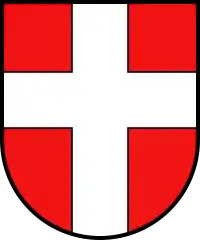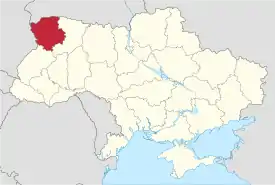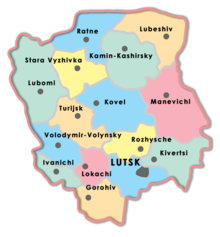Volyn Oblast
Volyn Oblast (Ukrainian: Волинська область, translit. Volyns’ka oblast’; also referred to as Volyn’, Wołyń or Lodomeria) is an oblast (province) in northwestern Ukraine. Its administrative center is Lutsk. Kovel is the westernmost town and the last station in Ukraine of the rail line running from Kyiv to Warsaw. Population: 1,031,421 (2020 est.)[5]
Volyn Oblast
Волинська область Volyns’ka oblast’ | |
|---|---|
| Volynska oblast[1] | |
 Flag  Coat of arms | |
| Nickname(s): Волинь (Volyn), Polish: Wołyń | |
 | |
| Country | |
| Administrative center | Lutsk |
| Government | |
| • Governor | Yuriy Pohuliaiko[2][3] |
| • Oblast council | 64 seats |
| • Chairperson | Ihor Palytsia[4] (UKROP[4]) |
| Area | |
| • Total | 20,144 km2 (7,778 sq mi) |
| Area rank | Ranked 20th |
| Population (2020) | |
| • Total | 1,031,421 |
| • Rank | Ranked 24th |
| • Density | 51/km2 (130/sq mi) |
| Time zone | UTC+2 (EET) |
| • Summer (DST) | UTC+3 (EEST) |
| Postal code | |
| Area code | +380-33 |
| ISO 3166 code | UA-07 |
| Raions | 16 |
| Cities (total) | 11 |
| • Regional cities | 4 |
| Urban-type settlements | 22 |
| Villages | 1053 |
| FIPS 10-4 | UP24 |
| Website | www.voladm.gov.ua |
History
Volyn was once part of Kievan Rus' before becoming an independent local principality and an integral part of the Halych-Volynia, one of Kievan Rus' successor states. In the 15th century, the area came under the control of neighbouring Grand Duchy of Lithuania, in 1569 passing over to Poland and then in 1795, until World War I, to the Russian Empire where it was a part of the Volynskaya Guberniya. In the interwar period most of the territory, organized as Wołyń Voivodeship was under Polish control.
In 1939 when following the Molotov-Ribbentrop pact Poland was invaded and divided by Nazi Germany and the Soviet Union, Volyn was joined to the Soviet Ukraine, and on December 4, 1939 the oblast was organized.

Many Ukrainians rejoiced at the "reunification", but the Polish minority suffered a cruel fate. Thousands of Poles, especially retired Polish officers and intelligentsia were deported to Siberia and other areas in the depths of the Soviet Union. A high proportion of these deportees died in the extreme conditions of Soviet labour camps and most were never able to return to Volyn again.
In 1941 Volyn along with the Soviet Union was invaded by the Nazi Germany's Barbarossa Offensive. Nazis alongside Ukrainian collaborators completed their holocaust of the Jews of Volhynia in late 1942.
Partisan activity started in Volyn in 1941, soon after German occupation. Partisans were involved in the Rail War campaign against German supply lines and were known for their efficiency in gathering intelligence and for sabotage. The region formed the basis of several networks and many members of the local population served with the partisans. The Poles in the area became part of the Polish Home Army, which often undertook operations with the partisan movement.
UPA initially supported Nazi Germany which had in turn supported them with financing and weaponry before the start of World War II. Many served in the various RONA and SS units. Once they became disillusioned with the Nazi program, they independently began to target all non Ukrainians (Poles, Jews, Russians, among others) for extermination. Some 30,000 to 60,000 Poles, Czechs, remaining Jews, and Ukrainians who tried to help others escape (Polish sources gave even higher figures) and later, around 2,000 or more Ukrainians were killed in retaliation (see Massacres of Poles in Volhynia).
In January 1944 the Red Army recaptured the territory from the Nazis.
In the immediate aftermath of World War II the Polish-Soviet border was redrawn based on the Curzon line. Volyn, along with the neighbouring provinces became an integral part of the Ukrainian SSR. Most Poles who remained in the eastern region were forced to leave to the Recovered Territories of western Poland (the former easternmost provinces of Germany) whose German population had been expelled. Some of the Ukrainians on the western side, notably around the city of Kholm (Chełm in Polish), were also forcibly relocated to Ukraine.
The area underwent rapid industrialisation including the construction of the Lutskiy Avtomobilnyi Zavod. Nevertheless, the area remains one of the most rural throughout the former Soviet Union.
Historical sites
The following historical-cultural sites were nominated in 2007 for the Seven Wonders of Ukraine.
- Upper Castle
- Volodymyr-Volynsky historical-cultural complex
- Villa-museum of Lesia Ukrainka
Relics
- Painting of the Holm's Virgin Mary
Politics
- Former Chairmen of Oblast Council
- 2006 – Vasyl Dmytruk Lytvyn's Bloc
- 2006 – Anatoliy Hrytsiuk
Subdivisions

The Volyn Oblast is administratively subdivided into 4 raions (districts).
| Name | Center | Center population | Area (km2) |
Population (thousand people) |
Hromadas |
|---|---|---|---|---|---|
| Volodymyr-Volynskyi Raion | Volodymyr-Volynskyi | 38,9 | 2558,2 | 174,7 | 11 |
| Kamin-Kashyrskyi Raion | Kamin-Kashyrskyi | 12,5 | 4693,4 | 132,4 | 5 |
| Kovel Raion | Kovel | 68,2 | 7647,9 | 271 | 23 |
| Lutsk Raion | Lutsk | 221,1 | 5247,8 | 457,3 | 15 |
| Hromada | Type | Center | Raion |
|---|---|---|---|
| Lutsk | city | Lutsk | Lutsk |
| Volodymyr-Volynskyi] | city | Volodymyr-Volynskyi | Volodymyr-Volynskyi |
| Kovel | city | Kovel | Kovel |
| Novovolynsk | city | Novovolynsk | Volodymyr-Volynskyi |
| Ustyluh | city | Ustyluh | Volodymyr-Volynskyi |
| Zymne | village | Zymne | Volodymyr-Volynskyi |
| Ovadne | village | Ovadne | Volodymyr-Volynskyi |
| Berestechko | city | Berestechko | Lutsk |
| Horokhiv | city | Horokhiv | Lutsk |
| Marianivka | town | Marianivka | Lutsk |
| Ivanychi | town | Ivanychi | Volodymyr-Volynskyi |
| Lytovezh | village | Lytovezh | Volodymyr-Volynskyi |
| Pavlivka | village | Pavlivka | Volodymyr-Volynskyi |
| Poromiv | village | Poromiv | Volodymyr-Volynskyi |
| Kamin-Kashyrskyi | city | Kamin-Kashyrskyi | Kamin-Kashyrskyi |
| Soshychne | village | Soshychne | Kamin-Kashyrskyi |
| Kivertsi | city | Kivertsi | Lutsk |
| Olyka | town | Olyka | Lutsk |
| Tsuman | town | Tsuman | Lutsk |
| Holoby | town | Holoby | Kovel |
| Lublynets | town | Lublynets | Kovel |
| Velytsk | village | Velytsk | Kovel |
| Dubove | village | Dubove | Kovel |
| Kolodiazhne | village | Kolodiazhne | Kovel |
| Povorsk | village | Povorsk | Kovel |
| Lokachi | town | Lokachi | Volodymyr-Volynskyi |
| Zaturtsi | village | Zaturtsi | Volodymyr-Volynskyi |
| Torchyn | town | Torchyn | Lutsk |
| Boratyn | village | Boratyn | Lutsk |
| Horodyshche | village | Horodyshche | Lutsk |
| Pidhaitsi | village | Pidhaitsi | Lutsk |
| Liubeshiv | town | Liubeshiv | Kamin-Kashyrskyi |
| Liuboml | city | Liuboml | Kovel |
| Holovne | town | Holovne | Kovel |
| Vyshniv | village | Vyshniv | Kovel |
| Rivne | village | Rivne | Kovel |
| Kolky | town | Kolky | Lutsk |
| Manevychi | town | Manevychi | Kamin-Kashyrskyi |
| Prylisne | village | Prylisne | Kamin-Kashyrskyi |
| Zabolottia | town | Zabolottia | Kovel |
| Ratne | town | Ratne | Kovel |
| Velymche | village | Velymche | Kovel |
| Zabrody | village | Zabrody | Kovel |
| Samary | village | Samary | Kovel |
| Rozhyshche | city | Rozhyshche | Lutsk |
| Dorosyni | village | Dorosyni | Lutsk |
| Kopachivka | village | Kopachivka | Lutsk |
| Stara Vyzhivka | town | Stara Vyzhivka | Kovel |
| Dubechne | village | Dubechne | Kovel |
| Serekhovychi | village | Serekhovychi | Kovel |
| Smidyn | village | Smidyn | Kovel |
| Lukiv | town | Lukiv | Kovel |
| Turiisk | town | Turiisk | Kovel |
| Shatsk | town | Shatsk | Kovel |
Demography
Age structure
- 0–14 years: 19.0%
 (male 101,739/female 95,332)
(male 101,739/female 95,332) - 15–64 years: 68.2%
 (male 344,359/female 363,116)
(male 344,359/female 363,116) - 65 years and over: 12.8%
 (male 42,221/female 90,463) (2013 official)
(male 42,221/female 90,463) (2013 official)
Median age
- total: 35.7 years

- male: 33.2 years

- female: 38.3 years
 (2013 official)
(2013 official)
See also
References
- Syvak, Nina; Ponomarenko, Valerii; Khodzinska, Olha; Lakeichuk, Iryna (2011). Veklych, Lesia (ed.). "Toponymic Guidelines for Map and Other Editors for International Use" (PDF). United Nations Statistics Division. scientific consultant Iryna Rudenko; reviewed by Nataliia Kizilowa; translated by Olha Khodzinska. Kyiv: DerzhHeoKadastr and Kartographia. p. 20. ISBN 978-966-475-839-7. Retrieved 2020-10-06.
- "Government adopts a series of personnel decisions". Cabinet of Ministers of Ukraine. October 28, 2019. Retrieved November 23, 2019.
- "Trofimov introduces new head of Volyn Regional State Administration". Ukrinform. December 3, 2019. Retrieved December 3, 2019.
- "Austrian ski resort of Semmering losing faith in Ukrainian oligarch investors". Deutsche Welle. Retrieved 22 December 2017.
- "Чисельність наявного населення України (Actual population of Ukraine)" (PDF) (in Ukrainian). State Statistics Service of Ukraine. Retrieved 30 September 2020.
External links
- Volyn Oblast State Administration (in Ukrainian)
- Volyn Region (Newspaper) (in Ukrainian)
- Picture album (in Ukrainian)